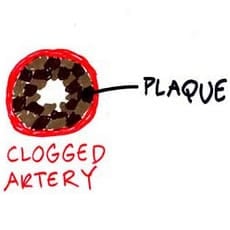Types of fat in food
May 13, 2010, Updated Dec 10, 2016

We’ve come a long way since the “Fat-Free” craze of the 90s, and it’s now generally accepted that not all fats are bad. We have since learned that fats can be quite beneficial. In fact, our bodies need fat — it’s an essential nutrient.
I’m not going to get too technical here; the important thing is to know which types of fats are “good” and which types are “bad,” and then to start paying attention to which ones you’re putting in your body.
Keep in mind that most foods contain more than one type of fat. I’ve also left cholesterol out of this discussion for now.
Monounsaturated Fats and Polyunsaturated Fats should comprise the majority of your fat & oil intake.
Consuming unsaturated fats may lower your risk of heart disease by reducing the total cholesterol and low-density lipoprotein (LDL) cholesterol levels in your blood. There is evidence that the “Omega-3” polyunsaturated fats may be especially beneficial; they may decrease the risk of coronary artery disease, help with irregular heartbeats, and lower blood pressure.
Good sources of polyunsaturated fat include vegetable oils (safflower, soy, sesame, corn, and sunflower oils), nuts, and seeds. Good Omega-3 sources include fatty cold-water fish (such as salmon), flaxseeds*, flax oil, and walnuts.
Good Monounsaturated fat sources include olive oil, peanut oil, canola oil, avocados, nuts and seeds.
Saturated Fat should be a very small portion of your fat intake, contributing no more than 10% of your calories. For a 2,000 calorie diet, that means no more than about 20 grams of sat fat a day.
There is no “safe” intake amount of Trans Fats (trans-fatty acids) — they should be completely avoided. The USDA has not yet set an upper limit of trans fat intake. The American Heart Association says to limit it to 1% of overall calories — which translates roughly to no more than 2 grams of trans fat per day.
Saturated fats are found in animal products (meat, fish, eggs, dairy products) and tropical oils (coconut oil and palm oil).
Most trans-fats we consume are man-made (though it is found in butter and other natural sources) through a process of hydrogenation. Hydrogen is added to a liquid oil so it will become a solid or semi-solid fat at room temperature. The classic example is turning canola oil into margarine.
Hydrogenated oils taste good, have good cooking properties, and good “mouth-feel,” but are now known to be very unhealthy. Any product that contains a “partially hydrogenated” vegetable oil contains trans fat and should be avoided. Fried foods often contain trans fats as well.
Tomorrow I’ll start to apply these guidelines — translating the complicated “percent of total calories” into actually useful information!
—
* Eating whole flaxseeds is pretty much pointless, since they just pass through our systems undigested (we can’t break down the shell). Get flaxseed meal instead, and store it in the fridge.
Recommended Reading:
Center for Science in the Public Interest on trans fat
American Heart Association on fat
USDA 2005 Dietary Guidelines (PDF) — Chapter 6, Page 29
Photo by ricko.




















Hello, thank you for your blog, trying and learning to eat clean it is not that easy 🙁 but we are trying our best. Question, which oils should I cook with if u want to “fry” fish? I mean I try not to fry anything but I LOVE fry fish of course I just use a little bit of oil. Thanks
Hi Florens – I’d suggest olive oil, peanut oil, or even coconut oil (Since writing this post, I’ve come to realize that the saturated fat in coconut oil is likely not problematic) . You might also want to check out this Cooking Oil Comparison Chart — which will help you with your oil choices. 🙂
https://eatingrules.com/cooking-oil-comparison-chart/
Hi Andrew,
Just want to say, I really enjoy your blog and website in general. Quick question about your thoughts on fats, though. I have been reading a lot of nutritional articles lately that talk about the importance of saturated fat in the diet, and that saturated fat has been mistakenly blamed for heart disease, etc. This blog post sums it up nicely, and has lots of links at the bottom to other articles. http://deliciouslyorganic.net/hashed-browns/
I also read Nourishing Traditions, if you’re familiar with that book or with the work of Weston Price.
Would love to hear your thoughts on this perspective!
Thanks.
Hi Shereen,
Glad you like my site! My story is actually similar to Carrie’s. Note that this post was from May 2010 — about a month after I started the blog. I was basing my sources primarily on government guidelines, which I figured (naively, perhaps) were the most scientifically sound. I’ve since come to realize that’s not the case, especially considering the heavy influence the food industry has had in the guidelines themselves. Two of my more recent posts are good examples of my current thinking – if you haven’t seen them yet, take a look:
http://www.eatingrules.com/2012/01/what-kind-of-milk-should-i-drink/
http://www.eatingrules.com/2012/02/cooking-oil-comparison-chart/
I’m familiar with the Weston A. Price Foundation, and while I agree with much (though not all) of what they recommend, I sometimes find their extremism (particularly that of Sally Fallon and many of her “followers”) can border on distateful.
Hope that helps explain!
Best,
Andrew